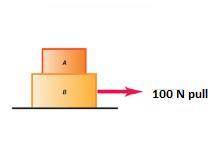
Physics, 29.06.2019 17:00 bradenjesmt1028
Block a is accelerating with block b at a rate of 0.800 m/s2 along a frictionless surface. it suddenly encounters a surface that supplies 25.0 n a friction. what is the new acceleration? a. 0.4 m/s2 b. 1.0 m/s2 c. 0.8 m/s2 d. 0.6 m/s2

Answers: 1


Another question on Physics

Physics, 21.06.2019 21:40
This problem has been solved! see the answera non-uniform fire escape ladder is 6.0m long whenextended to the icy alley below. it is held at the top by africtionless pivot, and there is neglibible frictional force fromthe icy surface at the bottom. the ladder weighs 250n, and it'scenter of gravity is 2.0m along the ladder from the bottom. amother and child of total weight 750n are on the ladder 1.5m fromthe pivot. the ladder makes an angle θ with the horizontal.find the magnitude and direction ofa) the force exerted by the icy alley on the ladderb) the force exerted by the ladder on the pivotc) do your answers in part a and b depend on the angle?
Answers: 3

Physics, 22.06.2019 03:10
Athin plate moves between two parallel, horizontal, stationary flat surfaces at a constant velocity of v = 7.5 m/s. the two stationary surfaces are spaced 4 cm apart, and the medium between them is filled with oil whose viscosity is 0.9 n·s/m2. the part of the plate immersed in oil at any given time is 2 m long and 0.5 m wide. if the plate moves through the mid-plane between the surfaces, determine the force required to maintain this motion. what would your response be if the plate was 1 cm from the bottom surface (h2) and 3 cm from the top surface (h1)? if the plate moves through the mid-plane between the surfaces, the force required to maintain the motion will be n. if the plate was 1 cm from the bottom surface (h2) and 3 cm from the top (h1) surface, the force required to maintain the motion would be n.
Answers: 2

Physics, 22.06.2019 03:30
As part of an industrial process, air as an ideal gas at 10 bar, 400k expands at steady state through a valve to a pressure of 4 bar. the mass flow rate of air is 0.5 kg/s. the air then passes through a heat exchanger where it is cooled to a temperature of 295k with negligible change in pressure. the valve can be modeled as a throttling process, and kinetic and potential energy effects can be neglected. (a) for a control volume enclosing the valve and heat exchanger and enough of the local surroundings that the heat transfer occurs at the ambient temperature of 295 k, determine the rate of entropy production, in kw/k. (b) if the expansion valve were replaced by an adiabatic turbine operating isentropically, what would be the entropy production? compare the results of parts (a) and (b) and discuss.
Answers: 3

Physics, 22.06.2019 03:30
Two polarizers are oriented at 24.0∘ to one another. light polarized at a 12.0-degree angle to each polarizer passes through both. what is the transmitted intensity (%)?
Answers: 2
You know the right answer?
Block a is accelerating with block b at a rate of 0.800 m/s2 along a frictionless surface. it sudden...
Questions


Physics, 23.11.2020 23:00

Mathematics, 23.11.2020 23:00







Mathematics, 23.11.2020 23:00

Mathematics, 23.11.2020 23:00

Social Studies, 23.11.2020 23:00

Mathematics, 23.11.2020 23:00


Mathematics, 23.11.2020 23:00

Mathematics, 23.11.2020 23:00

Mathematics, 23.11.2020 23:00

Social Studies, 23.11.2020 23:00

Mathematics, 23.11.2020 23:00








 . Hence, this is the required solution.
. Hence, this is the required solution.


